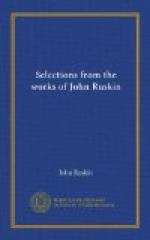Let us, however, proceed with our paper.
“One may very safely recommend a little more enthusiasm to the modern Painters; too much is certainly not the vice of the present age. The Italians seem to have been continually declining in this respect, from the time of Michael Angelo to that of Carlo Maratti,[44] and from thence to the very bathos of insipidity to which they are now sunk; so that there is no need of remarking, that where I mentioned the Italian painters in opposition to the Dutch, I mean not the moderns, but the heads of the old Roman and Bolognian schools; nor did I mean to include, in my idea of an Italian painter, the Venetian school, which may be said to be the Dutch part of the Italian genius. I have only to add a word of advice to the Painters,—that, however excellent they may be in painting naturally, they would not flatter themselves very much upon it; and to the Connoisseurs, that when they see a cat or a fiddle painted so finely, that, as the phrase is, it looks as if you could take it up, they would not for that reason immediately compare the Painter to Raffaelle and Michael Angelo.”
In this passage there are four points chiefly to be remarked. The first, that in the year 1759 the Italian painters were, in our author’s opinion, sunk in the very bathos of insipidity. The second, that the Venetian painters, i.e. Titian, Tintoret, and Veronese, are, in our author’s opinion, to be classed with the Dutch; that is to say, are painters in a style “in which the slowest intellect is always sure to succeed best.” Thirdly, that painting naturally is not a difficult thing, nor one on which a painter should pride himself. And, finally, that connoisseurs, seeing a cat or a fiddle successfully painted, ought not therefore immediately to compare the painter to Raphael or Michael Angelo.
Yet Raphael painted fiddles very carefully in the foreground of his St. Cecilia,—so carefully, that they quite look as if they might be taken up. So carefully, that I never yet looked at the picture without wishing that somebody would take them up, and out of the way. And I am under a very strong persuasion that Raphael did not think painting “naturally” an easy thing. It will be well to examine into this point a little; and for the present, with the reader’s permission, we will pass over the first two statements in this passage (touching the character of Italian art in 1759, and of Venetian art in general), and immediately examine some of the evidence existing as to the real dignity of “natural” painting—that is to say, of painting carried to the point at which it reaches a deceptive appearance of reality.
[35] The full title of this chapter is
“Of the Received Opinions
touching the ‘Grand Style.’”
[36] I have put this sentence in a parenthesis, because it is inconsistent with the rest of the statement, and with the general teaching of the paper; since that which “attends only to the invariable” cannot certainly adopt “every ornament that will warm the imagination.” [Ruskin.]
[37] Stanza 6 of Byron’s Prisoner
of Chillon, quoted with a slight
inaccuracy.




